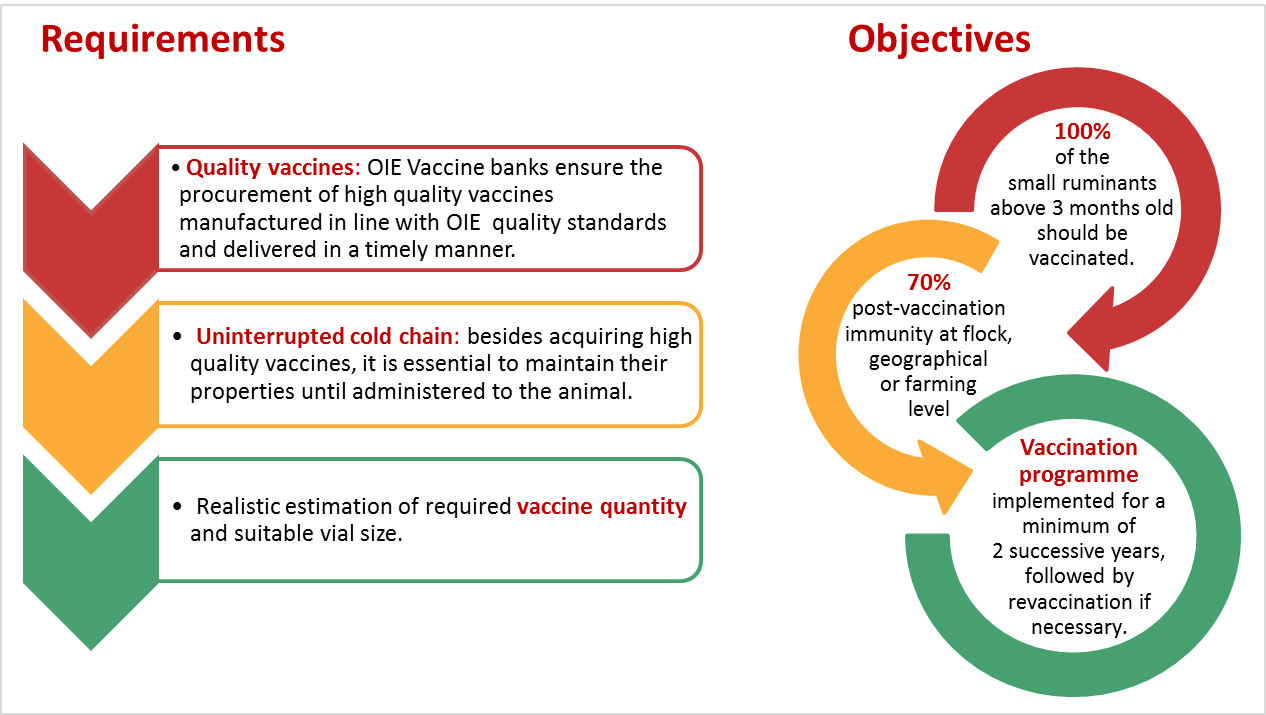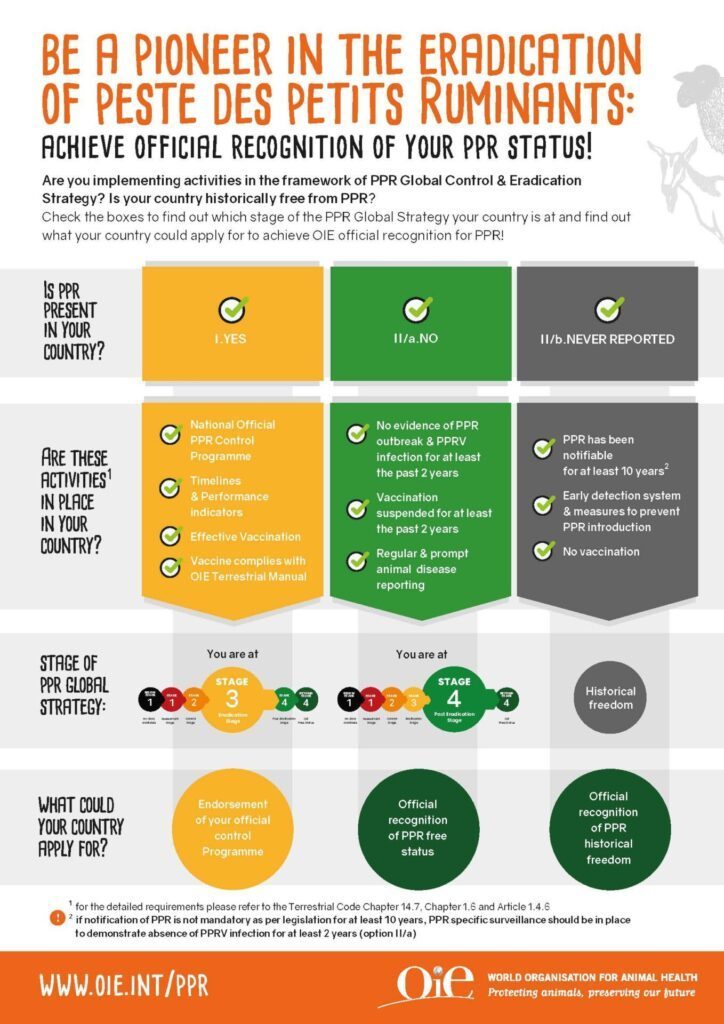Peste des petits ruminants
Peste des petits ruminants (PPR) is caused by a morbillivirus closely related to rinderpest virus, and affects goats, sheep, and some wild relatives of domesticated small ruminants, as well as camels. It is characterised by severe morbidity and mortality rates and has a high economic impact in areas of Africa, the Middle East, and Asia, where small ruminants contribute to guaranteeing livelihoods. PPR is an WOAH-listed disease and must be reported to the WOAH , according to the Terrestrial Animal Health Code. Countries have the possibility to apply for the official recognition by the WOAH of their freedom from PPR for their whole country or for a zone, and for the endorsement of their national official control programme for PPR. Together, WOAH and the FAO developed the Global Control and Eradication Strategy of PPR and have set the goal of eradicating the disease by 2030. Efficient PPR vaccines are available and can induce life-long protective immunity in vaccinated animals.
Links to Code and Manual
-
Terrestrial code
-
Terrestrial manual
What is PPR?
Peste des petits ruminants (PPR) is a viral disease, caused by a morbillivirus closely related to rinderpest virus, which affects goats, sheep, and some wild relatives of domesticated small ruminants, as well as camels. It was first reported in Ivory Coast in 1942.
It is characterised by severe morbidity and mortality rates, and has a high economic impact in areas of Africa, the Middle East, and Asia, where small ruminants contribute to guaranteeing livelihoods.
Affected animals present high fever and depression, along with eye and nose discharges. Animals cannot eat, as the mouth becomes covered in painful erosive lesions and the animals suffer from severe pneumonia and diarrhoea. Death is frequently the outcome.
PPR is on the list of notifiable diseases. Members are obliged to report cases and outbreaks to the Organisation, according to the Terrestrial Animal Health Code.
On the way to eradicate PPR by 2030
Peste des petits ruminants (PPR) is a contagious transboundary disease which has severe negative socio-economic impacts on the income of livestock farmers and, in particular, the livelihoods and food security of the most vulnerable rural communities, notably of women. WOAH and the FAO, in their joint strategy for control and eradication of PPR, have set the goal of eradicating the disease by 2030.
The similarity between PPR virus and rinderpest virus allows for the lessons learned from rinderpest eradication to be used in the PPR eradication strategy.
In 2015, in Abidjan, Ivory Coast, high-level authorities and Chief Veterinary Officers from 70 countries endorsed the PPR Global Control and Eradication Strategy, which has been confirmed through the adoption of the Resolution N°25 voted at the 84th WOAH General Session of the World Assembly of WOAH Delegates. In line with the recommendations of the above mentioned conference, the FAO and WOAH have established a joint secretariat which will oversee the implementation of the adopted Strategy.
The odds are in our favour
The disease is caused
by only one serotype, and there is neither a carrier state nor a sustainable reservoir species outside domestic small ruminants.
A high quality vaccine,
which confers life-long immunity, is available and is quite inexpensive to produce.
There are effective
diagnostic assays for serological monitoring of vaccination programmes and detection of virus circulation.
Geographical distribution of PPR
PPR was first reported in 1942 in Ivory Coast.
Since then, the disease has spread far beyond its origin in Western Africa. In the past 15 years, its dissemination has been exponential and PPR is now present in over 70 countries across Asia, Africa, and the Near and Middle East, having reached Europe in 2016 (Georgia).
This has devastating consequences on families, communities and countries.
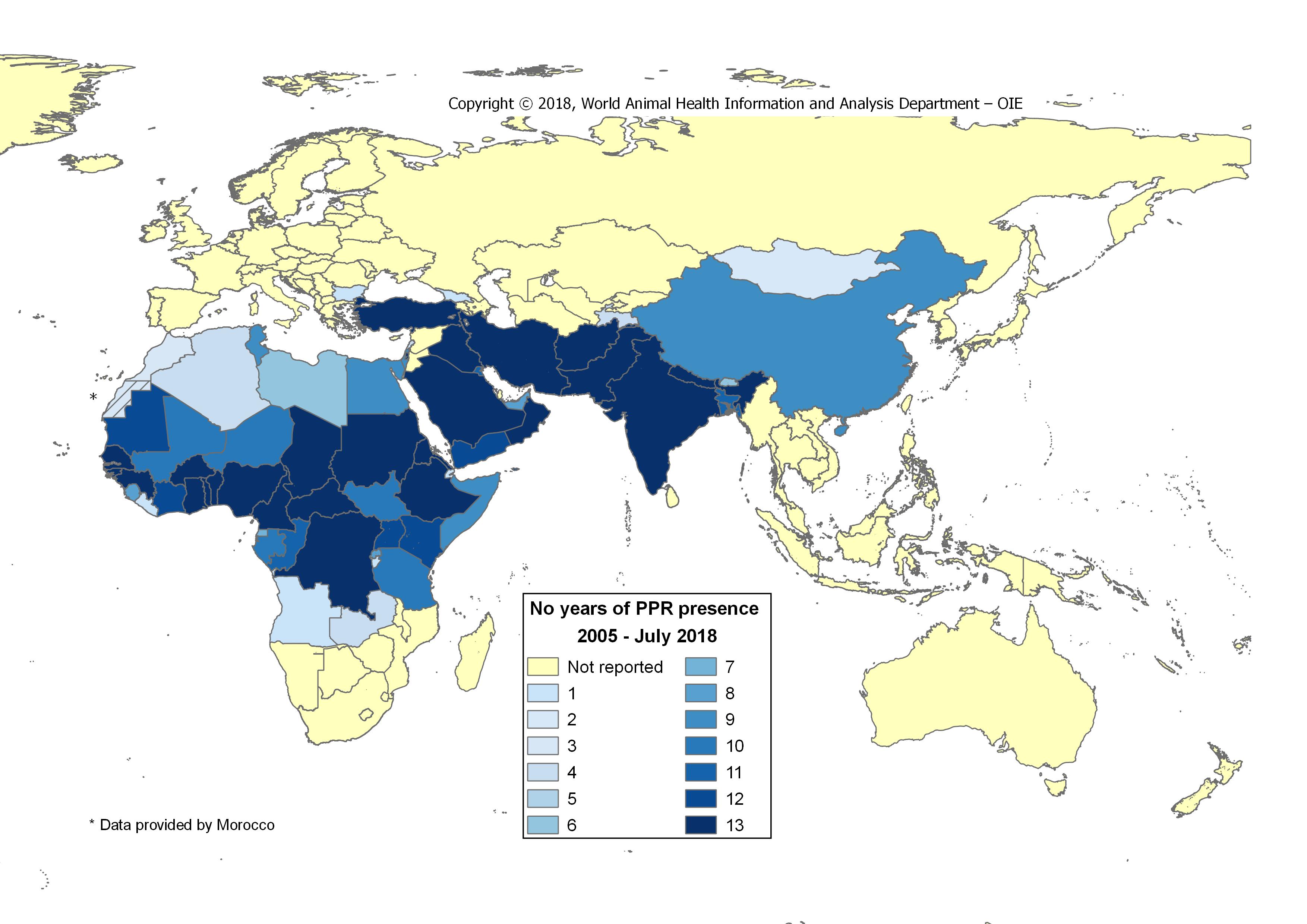
For additional information about the most recent reports please click here.
Controlling PPR to achieve social empowerment
Small ruminants have a huge importance on livelihoods of population in many regions of the world. The benefits and profits accrued from controlling the disease may result in improved productivity, food security, income generation and social empowerment.
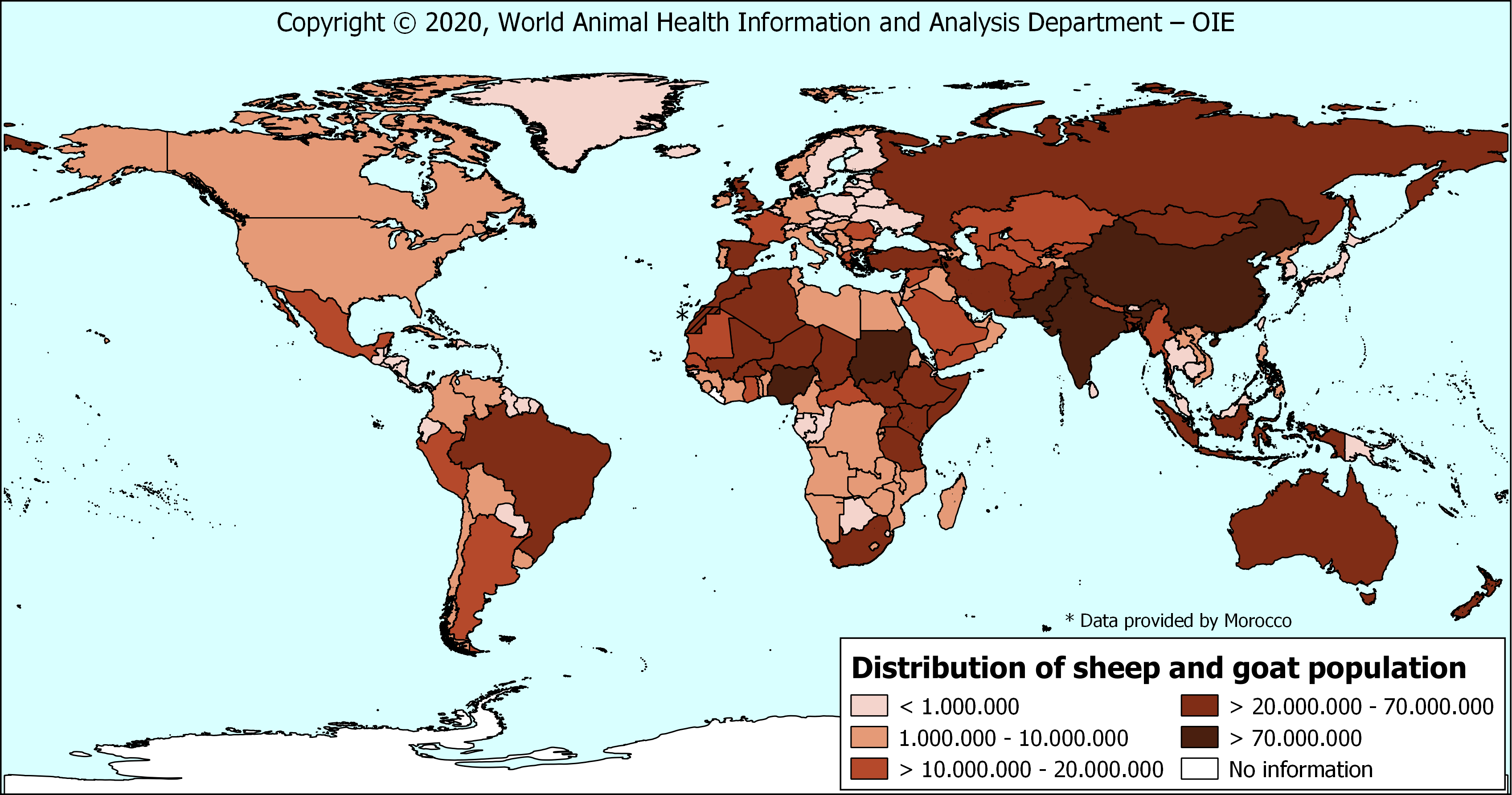
Africa, the Middle East, and Asia – the regions most affected by PPR – host over 80% of the world’s small ruminant population.
These animals are mainly owned by family farmers, who rely on them for obtaining food and other products, such as wool and skin, for income generation. They provide manure for fertilising crops, act as insurance for crop failure and drought, and contribute to food security and nutrition, livelihoods, national economic development and the overall well-being of people.
Sheep and goats therefore play an important role in the livelihoods and food security of poor families and contribute to national economic development.
Women are especially involved in small ruminant rearing, since they make up the majority of those caring for the animals. Their revenue is very important for investment in improved nutrition and child education. Therefore, by improving the small ruminant populations’ disease status, we can empower these women and give their offspring better perspectives for the future.
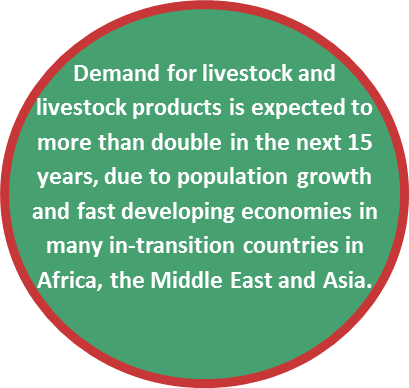
Eradicating PPR contributes to address global challenges
By fighting diseases such as PPR, veterinary professionals and para-professionals contribute to improve animal health and welfare. But not only… in doing so, they also work towards a better life for our society. The role of Veterinary Services is key to address global challenges. Watch this video and discover how WOAH accompanies their efforts every day.
Global strategy for the control and eradication of PPR
WOAH and the FAO developed jointly the Global Control and Eradication Strategy of PPR under the Global Framework for the progressive control of Transboundary Animal Diseases (GF-TADs).
Purpose
To establish the capacity of stakeholders and Veterinary Services to control and eradicate PPR while also addressing other small ruminant diseases.
Objectives
- Food security and better nutrition
- Animal and human health improvement
- Economics growth, empowerment of women, alleviation of poverty
- Providing the basis of income generation.
Also read
-
Strategic Plan
Global Strategy for the Control and Eradication of PPR
.pdf – 4 MB See the document
The strategy covers three components:
- a technical step-wise approach (stage 1 to stage 4) to control and eradicate the disease ;
- the strengthening of Veterinary Services in order to be able to carry out the technical component ;
- the control of other priority small ruminant diseases together with PPR in view of increasing the impact of the control efforts.
Step-wise approach
The four stages correspond to a combination of decreasing levels of epidemiological risk and increasing levels of prevention and control.
The stages range from stage 1, when the epidemiological situation is being assessed, to stage 4, when the country can provide evidence that there is no virus circulation, and it is ready to apply for the WOAH official status of freedom from PPR.
A country is “below stage 1” if there is no epidemiological information available, and “beyond stage 4” if the WOAH official status recognition has been concluded.

The strategy provides flexibility for countries to also take the shortcut options, as shown by the arrows in the diagram below.
For example, a country that determines, during stage 1, that there is no PPR virus circulating in the country may move directly to stage 4.

How to assign a country to a stage?
By assessing the following 5 technical elements:
- PPR diagnostic system(s);
- PPR surveillance system(s);
- PPR prevention and control system(s);
- Legal framework for prevention and control of PPR;
- Stakeholders’ involvement on PPR control.
How to assess the evolution within a stage and from stage to stage?
The PPR Monitoring and Assessment Tool (PMAT) has been specifically designed to monitor and evaluate the implementation of the Strategy. To assess the performance of Veterinary Services to support the technical activities of PPR control and eradication, the WOAH PVS Evaluation tool is also used.
Vaccination
Lessons learned from the Global Rinderpest Eradication Programme demonstrate that the use of a highly efficacious rinderpest vaccine capable of immunising animals against all rinderpest virus strains was a vital contributor to the campaign’s success. Similarly, efficient PPR vaccines are available and can induce life-long protective immunity in vaccinated animals.
Vaccination is thus one of the key tools to controlling PPR and has been identified as the main option in Stage 2 ‘Control’ and Stage 3 ‘Eradication’, of the Global Strategy for the control and eradication of PPR.
Have you read?
In Kenya, PPP initiatives have been launched to support large-scale vaccination against PPR. Discover in this interview with Dr Obadiah Nyaga Njagi, WOAH Delegate of Kenya, how these have benefitted their national action plan.
View the full interview on WOAH 2019 Activity Report.
PPR Global eradication Programme (GEP): 2017-2021
The push for PPR global eradication is framed as a 15-year process running to 2030.
To highlight the technical and policy tools needed to lay the foundation for implementing the Global Strategy, the FAO/WOAH joint PPR Secretariat has designed a programme that covers the first five-year period. Its elaboration has involved key stakeholders such as technical specialists, regional or national beneficiaries, and decision-makers and its implementation will be coordinated by this joint secretariat.
The GEP is a multi-country, multi-stage process that will decrease epidemiological risk levels and increase prevention and control of PPR, by first reducing its prevalence in the countries currently infected. It will also develop the capacity for non-infected countries to demonstrate the absence of PPR virus, as a basis for official recognition of PPR free status by the WOAH.
Planned activities for the next five years will aim at:
- Promoting an enabling environment and reinforcing veterinary capacities;
- Supporting diagnostic and surveillance systems;
- Eradicating PPR;
- Coordinating and managing the process at global, regional and national levels.
Regional roadmaps
The transborder nature of PPR requires actions to be harmonised in all countries in the same region.
Therefore, regional coordination is essential for a successful implementation of the Global Strategy.
The affected countries have been groups into 9 regions in which the progress towards eradication of PPR will be assessed in regional roadmap meetings. Regional action plans outline the control and eradication measures to be implemented at national and regional levels.
A first round of meetings on the PPR regional roadmap took place in the nine regions affected and a second round has been initiated, with meetings organised for the following three regions:
- Central Africa
- Middle East
- Economic Cooperation Organization of Central Asia (ECO)
These meetings made it possible to have a detailed understanding of the situation in each country and establish a long-term calendar for eradicating the disease and supporting countries in obtaining disease-free status. This regional overview also helps raise awareness among decision-makers and facilitate the mobilisation of resources at national level.
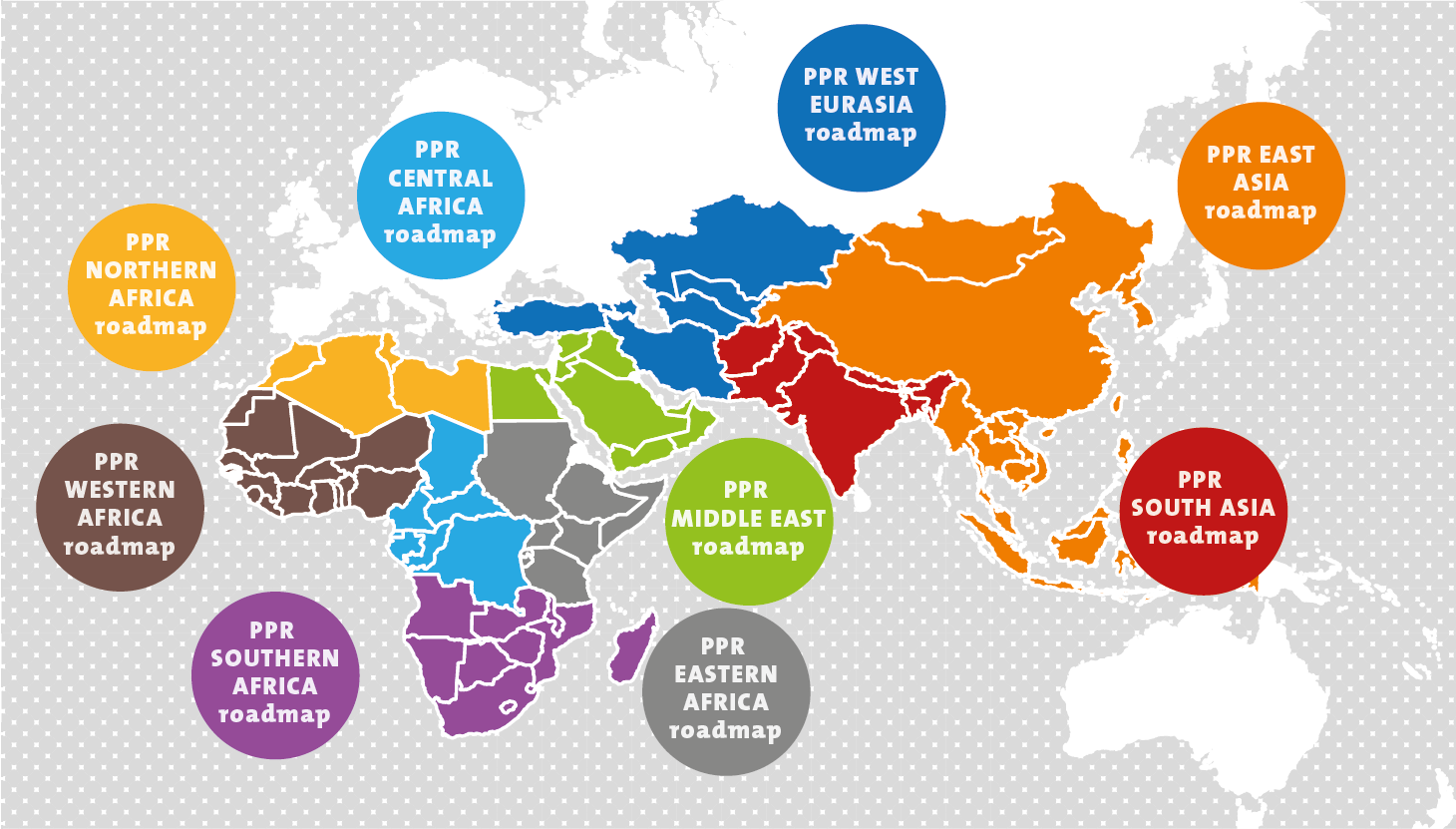
WOAH PPR regional Vaccine Bank
The PPR vaccine bank mechanism allows high-quality vaccines complying with WOAH international standards to be delivered to countries in a timely manner. The rolling mechanism of this vaccine bank ensures that the purchased vaccines are produced upon request, thereby extending the expiry date of vaccines delivered to the country. It also helps limit the multiplication of procurement procedures in countries, and enables economies of scale through the reduction of purchase costs per vaccine. Vaccine bank contracts can also include more sophisticated financial and replenishment mechanisms with possible clauses for direct purchase by beneficiary countries or by international organisations and partners.
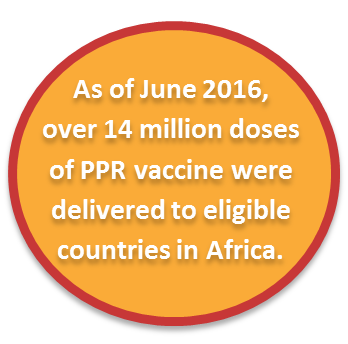
Recognising that PPR can be eradicated and that vaccination is central to the achievement of this much-needed endeavour, in 2012 and in the framework of the Vaccine Standards and Pilot Approach to PPR control in Africa (VSPA) programme financed by the Bill & Melinda Gates Foundation, the WOAH established a PPR Vaccine Bank for eligible countries in Africa.
This programme has underlined that the availability of high-quality and WOAH compliant PPR vaccines is of paramount importance for implementing effective vaccination campaigns. It also demonstrates the role of an WOAH regional Vaccine Bank in facilitating the harmonisation of PPR control methods in Africa.As of June 2016, the WOAH has already delivered a total of more than 14 million doses of PPR vaccines to targeted African countries. This includes 4 million doses of PPR vaccines purchased directly by a country from the WOAH PPR Vaccine Bank for Africa, and delivered with financial support provided by the World Bank.
The World Bank is also providing support to the WOAH PPR Vaccine Bank for Africa through the Regional Sahel Pastoralism Support Project (PRAPS), a six-year project (2015-2020) which targets six countries in Western and Central Africa. In this context, 72.8 million doses of PPR vaccines have already been ordered though the WOAH PPR Vaccine Bank for Africa.
WOAH is currently strengthening and expanding its PPR Vaccine Bank in order to continue to provide its Member Countries with access to high-quality vaccines at a highly competitive rate in the future. The WOAH strengthened its PPR vaccine bank in 2016 by selecting, after an international call for tender, 2 producers to supply high quality vaccines at an extremely competitive price available to the countries.

Strengthening Veterinary Services
The PPR Global Strategy recognises that good quality of Veterinary Services are indispensable for the successful and sustainable implementation of PPR (and other major Transboundary Animal Diseases) prevention and control activities, in addition to their other mandates and activities such as food safety, prevention of antimicrobial resistance or animal welfare.
Therefore, Veterinary Services capacity must be strengthened as a country moves towards. This in turn will create more cost-effective opportunities to control other priority diseases. This will be attained through appropriate combinations of activities such as vaccinations against other major diseases, epidemiological investigations, diagnostic activities and treatments.
The WOAH PVS Pathway will serve to evaluate Veterinary Services compliance with WOAH standards, to identify the cost of the gaps to be addressed for compliance and to address other issues such as veterinary laboratories, relevant legislation and education.
Have you read?
To assess Nigeria’s specific needs to control PPR, the WOAH carried out a PVS Evaluation Follow-up mission with PPR Specific Content. In an interview, Dr Olaniran Alabi explains how this report guided him and his team to address specific shortcomings in their Veterinary Services to improve the national PPR control and eradication plan across the country.
-
Success Story
The PVS Pathway reports: tools for advocacy
View the full interview on WOAH 2019 Activity Report
In accordance with the World Organisation for Animal Health (WOAH, founded as OIE) procedure for official recognition of disease status, this page provides access to the List of WOAH Members officially recognised free from peste des petits ruminants (PPR) by the WOAH through the adoption of a resolution by the World Assembly of Delegates (Assembly) of the WOAH at the General Session in May every year.
A Member wishing to be officially recognised as disease-free by the WOAH should submit the questionnaire laid out in Chapter 1.6. of the WOAH Terrestrial Animal Health Code (Terrestrial Code) and comply with all requirements specified in the Terrestrial Code for PPR. The WOAH Scientific Commission for Animal Diseases (Scientific Commission) is responsible for undertaking, on behalf of the World Assembly, the assessment of WOAH Members’ applications for their compliance with WOAH standards. The assessment carried out by the Scientific Commission is based on the recommendations formulated by a relevant ad hoc Group composed of world specialists in disease control.
-
Questionnaire
A_Questionnaire_PPR
.docx – 87 KB See the document -
Questionnaire
A_Questionnaire_PPR_programme
.docx – 70 KB See the document
Subsequent to a disease outbreak or when the Scientific Commission determines that the conditions are not met anymore to demonstrate compliance with the relevant requirements of the Terrestrial Code, a disease status may be suspended. The Scientific Commission may decide to reinstate the suspended status when a Member has submitted an application which fulfils all the requirements requested for the recovery of official disease status laid out in the relevant Chapters of the Terrestrial Code. The suspensions and recoveries of disease status are announced by the Director General of the WOAH in consultation with the Scientific Commission and the list of these is kept up to date until adoption of a new resolution by the Assembly the following May.
Members with a disease free status officially recognised by the WOAH must submit an annual reconfirmation form by the end of November every year.
-
.docx – 51 KB See the document
-
.docx – 43 KB See the document
Map of PPR official status
List of PPR free Members
According to Resolution No. 25 (91st General Session, May 2024)
PPR free Members
Members recognised as free from PPR according to the provisions of Chapter 14.7. of the Terrestrial Code :
| Argentina | Czech Republic | Lesotho | Poland |
| Australia | Denmark | Liechtenstein | Portugal (3) |
| Austria | Ecuador | Lithuania | Romania** |
| Azerbaijan | Estonia | Luxembourg | Russia |
| Belgium | Eswatini | Madagascar | Singapore |
| Bolivia | Finland (1) | Malta | Slovakia |
| Bosnia and Herzegovina | France (2) | Mauritius | Slovenia |
| Botswana | Germany | Mexico | South Africa |
| Brazil | Greece* | New Caledonia | Spain (4) |
| Canada | Hungary*** | New Zealand | Sweden |
| Chile | Iceland | North Macedonia (Rep. of) | Switzerland |
| Chinese Taipei | Ireland | Norway | The Netherlands |
| Colombia | Italy | Paraguay | United Kingdom (5) |
| Croatia | Korea (Rep. of) | Peru | United States of America (6) |
| Cyprus | Latvia | Philippines | Uruguay |
(2) Including French Guiana, Guadeloupe, Martinique, Réunion, Saint Barthélémy, Saint Martin, Saint Pierre and Miquelon.
(3) Including Azores and Madeira.
(4) Including Balearic Islands and Canary Islands.
(5) Including Cayman Islands, Guernsey (incl. Alderney and Sark), Isle of Man, Jersey, Saint Helena and Falkland Islands (Malvinas). (A dispute exists between the Government of Argentina and the Government of the United Kingdom of Great Britain and Northern Ireland concerning sovereignty over the Falkland Islands (Malvinas) (see resolution 2065 (XX) of the General Assembly of the United Nations).
(6) Including American Samoa, Guam, Northern Mariana Islands, Puerto Rico and US Virgin Islands.
(*) Update on Resolution No. 25 adopted in May 2024 by the World Assembly of Delegates listing Greece as a “PPR free country”: Greece’s status has been suspended with effect from 8 July 2024.
(**) Update on Resolution No. 25 adopted in May 2024 by the World Assembly of Delegates listing Romania as a “PPR free country”: Romania’s status has been suspended with effect from 15 July 2024.
(***) Update on Resolution No. 25 adopted in May 2024 by the World Assembly of Delegates listing Hungary as a “PPR free country”: Hungary’s status has been suspended with effect from 23 January 2025.
PPR free zone(7)
Members recognised as having a zone free from PPR according to the provisions of Chapter 14.7. of the Terrestrial Code :
+ one zone located south of the Veterinary Cordon Fence, designated by the Delegate of Namibia in a document addressed to the Director General in November 2014.
(7) For detailed information on the delimitation of the zone of the Member recognised as PPR free, enquiries should be addressed to the Director General of the WOAH.
Suspension/reinstatement of status
Suspension of a Member’s PPR-free status
Hungary
Following an immediate notification received from the Delegate of Hungary on an outbreak of PPR in Szentgyörgyvölgy, Lenti, Zala, the “PPR-free country’’ status as recognised by the World Assembly of Delegates in terms of Resolution No. 25 in May 2024, is suspended with effect from 23 January 2025.
Romania
Following an immediate notification received from the Delegate of Romania on an outbreak of PPR in Baia, Ceamurlia De Jos, Tulcea, the “PPR-free country’’ status as recognised by the World Assembly of Delegates in terms of Resolution No. 25 in May 2024, is suspended with effect from 15 July 2024.
Greece
Following an immediate notification received from the Delegate of Greece on an outbreak of PPR in Kastraki, Kalambaka, Thessaly, the “PPR-free country’’ status as recognised by the World Assembly of Delegates in terms of Resolution No. 25 in May 2024, is suspended with effect from 8 July 2024.

